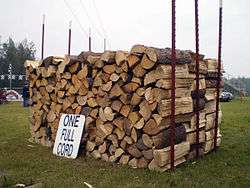Cord (unit)
The cord is a unit of measure of dry volume used to measure firewood and pulpwood in the United States and Canada.

A cord is the amount of wood that, when "racked and well stowed" (arranged so pieces are aligned, parallel, touching and compact), occupies a volume of 128 cubic feet (3.62 m3).[1] This corresponds to a well-stacked woodpile 4 feet (122 cm) high, 8 feet (244 cm) wide, and 4 feet (122 cm) deep; or any other arrangement of linear measurements that yields the same volume.
The name cord probably comes from the use of a cord or string to measure it.[2]
The cord-foot was a US unit of volume for stacked firewood, four feet long, four feet wide and one foot high - equal to one eighth of a cord.[3] Symbol for the unit was cd-ft.[4]
Definitions
In Canada, the cord is legally defined by Measurement Canada. The cord is one of three legal standards for the sale of firewood in Canada (stacked cubic metre, cubic foot, and cord). However the stacked cubic metre is now the preferred unit of measurement.[5]
In the United States, the cord is defined by statute in most states. The U.S. National Institute of Standards and Technology Handbook 130, section 2.4.1.2,[6] defines a cord and provides uniform regulations for the sale of fireplace and stove wood. In the metric system, wood is usually measured in steres and cubic metres: 1 stere = 1 m3 ≈ 0.276 cords.
Maine appears unique among U.S. states by also defining a "loose thrown cord" or pile of cut firewood: "A cord of 12 or 16 inches (30 or 41 cm) in length shall mean the amount of wood, bark and air contained in a space of 180 cubic feet (5.1 m3); and a cord of wood 24 inches (61 cm) in length shall mean the amount of wood, bark and air contained in a space of 195 cubic feet (5.5 m3). [1981, c. 219 (amd).]"[7]
Other non-official terms for firewood volume include standing cord, kitchen cord, running cord, face cord, fencing cord, country cord, long cord, and rick, all subject to local variation. These are usually taken to mean a well-stacked pile of wood in which the logs are shorter or longer than in a legal cord, to accommodate various burners. For example, a face cord commonly consists of wood that is 16 inches (41 cm) long.[8] The volume of a face cord therefore is typically 1/3 of the volume of a full cord even though it is 8 feet (244 cm) long and 4 feet (122 cm) high. A face cord is also called a rick in Midwestern United States.[9]
The term is used in other English-speaking countries, such as New Zealand,[10] but may not have a legal definition.
The "corde" was a unit of volume used before metrication in several French-speaking countries (France, Belgium and Luxemburg). Its value varied according to the region, but it was approximately 3 to 4 steres.
Heating value
One seasoned (dry) cord of red oak with a heating value of 22.1 million British thermal units per cord (6.4 GJ/m3) has the heating equivalent of 159 US gallons (132 imperial gallons; 602 litres) of fuel oil with a heating value of 138,700 British thermal units per US gallon (38.7 megajoules per litre).[11][12]
See also
- Board foot
- Cord-foot
- Cubic ton
- Forest product
- Hoppus foot
- Imperial units
- List of unusual units of measurement
- Measurement Canada
- Measurement Information Division of Industry Canada
- Petrograd Standard
- Units of measurement
References
- British Columbia Ministry of Forests and Range. "Glossary of Forestry Terms in British Columbia" (pdf). Retrieved 2008-09-04.
- "cord | Origin and meaning of cord by Online Etymology Dictionary". Retrieved 2019-01-11.
- Luther Ainsworth (1837). Practical Mercantile Arithmetic: In which the Theory and Practice of Arithmetic are Familiarly Explained and Illustrated, by a Great Variety of Mercantile, Mechanical and Mathematical Problems. Providence: B. Cranston. p. 220. ISBN 978-1130955545.
- Cardarelli, F. (2003). Encyclopaedia of Scientific Units, Weights and Measures. Their SI Equivalences and Origins. London: Springer. pp. 52. ISBN 978-1-4471-1122-1.
- Measurement Canada (2014). "Buying Firewood? Don't Get Burned".
- NIST, Weights and Measures Division (2006). "Uniform Laws and Regulations in the Areas of Legal Metrology and Engine Fuel Quality". NIST Handbook 130 - 2006 Edition. Archived from the original on 2008-10-10. Retrieved 2008-09-04.
- Maine Department of Agriculture
- Woodheat.org (2011). "What is a Cord? And How to Avoid Paying Too Much for One".
- "Archived copy". Archived from the original on 2013-09-22. Retrieved 2014-01-05.CS1 maint: archived copy as title (link)
- Consumer.org.nz What is a cord Archived 2014-02-24 at the Wayback Machine
- "Firewood BTU Comparison Charts".
- "Fuel Oil and Combustion Values".